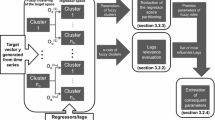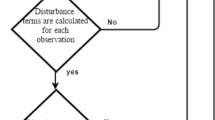Abstract
In time series analysis, such as other statistical problems, we may confront imprecise quantity. One case is a situation in which the observations related to underlying systems are imprecise. This paper proposes a semi-parametric autoregressive model for those real-world applications whose observed data are reported by fuzzy numbers. To this end, a hybrid method including nonparametric kernel-based approach and the least absolute deviations is suggested which allows us to estimate the parameters of the model and the fuzzy nonlinear function of the innovations, simultaneously. In order to examine the performance and effectiveness of the proposed fuzzy semi-parametric time series model, some common goodness-of-fit criteria are employed. The obtained results based on a practical example of simulated fuzzy time series data indicated that the proposed method is potentially effective for predicting fuzzy time series data.








Similar content being viewed by others
References
Bosq D (1996) Nonparametric statistics for stochastic process. Springer, New York
Chang PT (1997) Fuzzy seasonality forecasting. Fuzzy Sets Syst 90:1–10
Dubois D, Pap E, Prade H (2000) Hybrid probabilistic-possibilistic mixtures and utility functions. In: Fodor J, de Baets B, Perny P (eds) Preferences and decisions under incomplete knowledge, vol 51. Springer, Heidelberg, pp 51–73
Efromovich S (1999) Nonparametric curve estimation: methods, theory and applications. Springer, New York
Gasser T, Muller HG (1979) Kernel estimation of regression functions. In: Gasser, Rosenblatt (eds) Smoothing techniques for curve estimation. Springer, Heidelberg
Guney H, Bakir MA, Aladag CH (2018) A novel stochastic seasonal fuzzy time series forecasting model. Int J Fuzzy Syst 20:729–740
Hardle W (1990) Applied nonparametric regression. Cambridge University Press, New York
Hesamian G, Akbari MG, Asadollahi M (2017) Fuzzy semi-parametric partially linear model with fuzzy inputs and fuzzy outputs. Expert Syst Appl 71:230–239
Klement EP, Mesiar R, Pap E (2005) Archimax copulas and invariance under transformations. Comptes Rendus Mathematique 340:755–758
Klement EP, Mesiar R, Pap E (2004) Problems on triangular norms and related operators. Fuzzy Sets Syst 145:471–479
Klement EP, Mesiar R, Pap E (2000) Triangular norms, trends in logics 8. Kluwer Academic Publishers, Dordrecht
Kuo SC, Chen CC, Li ST (2015) Evolutionary fuzzy relational modeling for fuzzy time series forecasting. Int J Fuzzy Syst 17:444–456
Liu B (2013) Uncertainty theory, 4th edn. Springer, Berlin
Mesiar R (1997) Shape preserving additions of fuzzy intervals. Fuzzy Sets Syst 86:73–78
Pap E (1997) Pseudo-analysis as a mathematical base for soft computing. Soft Comput 1:61–68
Peng J, Liu B (2004) Some properties of optimistic and pessimistic values of fuzzy. IEEE Int Conf Fuzzy Syst 2:745–750
Robinson PM (1988) Root-n-consistent semi-parametric regression. Econometrica 56:931–954
Sharma S, Chouhan M (2014) A review: fuzzy time series model for forecasting. Int J Adv Sci Technol 2:32–35
Shim J, Hwang C, Hong DH (2009) Fuzzy semiparametric support vector regression for seasonal time series analysis. Commun Korean Stat Soc 16:335–348
Simonoff J (1996) Smoothing methods in statistics. Springer, New York
Singh P (2017) A brief review of modeling approaches based on fuzzy time series. Int J Mach Learn Cybern 8:1–24
Song Q, Chissom BS (1993) Fuzzy time series and its models. Fuzzy Sets Syst 54:269–277
Song Q, Chissom BS (1993) Forecasting enrollments with fuzzy time series-part I. Fuzzy Sets Syst 54:1–9
Taheri SM (2003) Trends in fuzzy statistics. Austrian J Stat 32:239–257
Taheri SM, Kelkinnama M (2012) Fuzzy linear regression based on least absolute deviations. Iran J Fuzzy Syst 9:121–140
Tanaka H, Uejima S, Asai K (1982) Linear regression analysis with fuzzy model. IEEE Trans Syst Man Cybern 12:903–907
Tsaur RC, Wang HF, Yang JCO (2002) Fuzzy regression for seasonal time series analysis. Int J Inf Technol Decis Mak 1:165–175
Tseng FM, Tzeng GH (2002) A fuzzy seasonal ARIMA model for forecasting. Fuzzy Sets Syst 126:367–376
Tseng FM, Tzeng GH, Yu HC, Yuan BJC (2001) Fuzzy ARIMA model for forecasting the foreign exchange market. Fuzzy Sets Syst 118:9–19
Viertl R (2011) Statistical methods for fuzzy data. Wiley, Chichester
Wang N, Zhang WX, Mei CL (2007) Fuzzy non-parametric regression based on local linear smoothing technique. Inf Sci 177:3882–3900
Wasserman L (2006) All of nonparametric statistics. Springer, New York
Watada J (1992) Fuzzy time series analysis and forecasting of sales volume. Omnitech Press, Heidelberg
Zadeh LA (1978) Fuzzy sets as a basis for a theory of possibility. Fuzzy Sets Syst 1:3–28
Zimmermann HJ (2010) Fuzzy set theory. Wiley Interdiscip Rev Comput Stat 2:317–332
Acknowledgements
The authors wish to thank anonymous referees for their valuable and constructive comments on this article. The authors declare no financial or non-financial.
Author information
Authors and Affiliations
Corresponding author
Ethics declarations
Conflict of interest
The authors declare no potential conflicts of interest.
Ethical standards
This article does not contain any studies with human participants or animals performed by any of the authors.
Additional information
Communicated by V. Loia.
Publisher's Note
Springer Nature remains neutral with regard to jurisdictional claims in published maps and institutional affiliations.
Rights and permissions
About this article
Cite this article
Zarei, R., Akbari, M.G. & Chachi, J. Modeling autoregressive fuzzy time series data based on semi-parametric methods. Soft Comput 24, 7295–7304 (2020). https://doi.org/10.1007/s00500-019-04349-w
Published:
Issue Date:
DOI: https://doi.org/10.1007/s00500-019-04349-w




